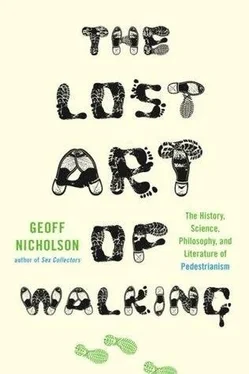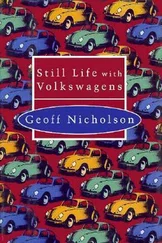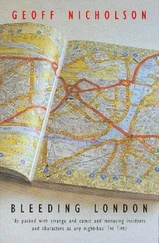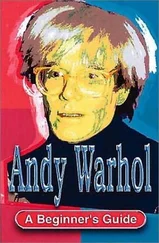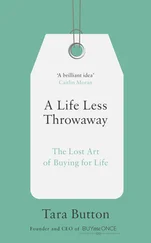Weston was a public figure and a showman. Postcards from the time show him to have been a flamboyant, barrel-chested dandy. He wore kid gloves, black velvet knee britches, and a cap with a plume. Sometimes he would deliver lectures along the way: ‘Tea Versus Beer’ was one.
Weston seemed only to get better as he got older. When he was seventy years old he planned to walk from New York to San Francisco in 100 days, but got delayed (he had to crawl through parts of the Rockies on his hands and knees), and it took him 104 days. This is the kind of failure most of us could live with, but Weston was bitterly disappointed, and to make amends he walked the return route (starting in Santa Monica) in 76 days.
Ultimately, New York was not kind to Weston. In his lectures he encouraged people to walk rather than drive, and in 1927, at age eighty-eight, he was run down by a New York taxicab — the automobile’s revenge. He was seriously injured, and had to spend the last two years of his life in a wheelchair.
It’s to be assumed that Weston was sober when he was run down. In 1884 in England he’d undertaken something called the Great Temperance Tour: 5,000 miles in one hundred days, with Sundays off, and the occasional performance of a temperance lecture titled ‘Struggling’. On the other hand, we do know that in 1871 he wagered $2,500 that he could walk a hundred miles in twenty-two hours with champagne as his only sustenance: a bet he won. Certainly after the accident he managed to find some patronage, and one can only hope it was enough to keep him in champagne, if that was what he wanted, since the pleasure of walking was no longer available to him.
♦
In Paul Auster’s novel City of Glass a detective named Quinn follows a character named Stillman as he wanders around New York’s Upper West Side. Eventually Quinn realizes that these wanderings, when plotted on a map, have a shape to them and are spelling out the phrase ‘Tower of Babel’. In fact he never does spell out the last two letters, EL, which Auster explains for the benefit of Gentiles is ‘the ancient Hebrew for God’.
Stillman’s wanderings make for a fine literary conceit, but even as you read the book, and look at Auster’s doodles that illustrate the walks, you realize that on the ground things wouldn’t be nearly so clear. Walking the shape of an O for instance is exceptionally difficult on a grid: Auster’s badly drawn O could be a badly drawn D, and the W in tower is so shapeless it might have been a V or a U, or a roller coaster, or as Quinn himself says, ‘a bird of prey perhaps, with its wings spread, hovering aloft in the air’. This is a big perhaps.
The walking of a shape, symbol, or word is one of the basic practices of psychogeography, what is called a ‘constrained walk’, exploring a city on foot while following a restrictive or perverse logic, which might include tossing a coin at each street corner to determine the route, walking so as to avoid all security cameras, walking in a dead straight line without regard to actual geography, and so on.
Psychogeography was a subject that had been exercising me, because I was about to go to New York for something called the Conflux psychogeography festival. With this in mind I’d been spending a lot of time staring at maps of the city, looking for patterns, hoping that the layout of streets might reveal some symbol or logo that could form the basis of my own constrained walk: a nuclear disarmament symbol, a Volkswagen trademark, a muted post horn. The only two I could make out on New York’s grid pattern were the cross and the swastika, and I didn’t feel much like walking either of those.
I was grateful to Auster’s book because it told me about the Roeblings, father and son, the men who built the Brooklyn Bridge. After Roebling Senior’s death, the son, Washington Augustus Roebling, took over the job and spent long periods working underwater supervising the building of the bridge’s caissons. He was down there so long he developed decompression sickness, the bends, and eventually became so disabled that he couldn’t walk and was confined to his home and had to watch the construction of the bridge from his window.
The psychogeography festival, it turned out, was to be based in Roebling Street in Williamsburg, Brooklyn, at the McCaig-Welles art gallery. The event was, and I’m quoting now;
‘the annual New York City festival where visual and sound artists, writers, urban adventurers, researchers and the public gather for four days to explore the physical and psychological landscape of the city. Say hello to Brooklyn!’
In truth I wasn’t only going to New York for the festival. I was going because I love the city, because I love walking there, and I intended to do plenty of walking under my own steam outside the festival. New York is a city where you end up doing a great deal of walking even when you don’t consciously decide to go walking at all. When I arrived I had no specific walking project in mind, but I hoped something would present itself.
♦
There are plenty of people who will tell you that walking in New York is a universally difficult and painful business. They cite the lack of flow and rhythm, the stopping and starting as each block presents you with a traffic signal and the instruction to walk or not walk. Of course, New York pedestrians try their damnedest not to obey instructions, to walk when they’re told not to, but self-preservation demands that once in a while you need to stop and let the traffic have its way. Walking in New York involves a lot of waiting to walk.
I lived in New York between 1996 and 2003, an interesting time, not least because it involved the removal of the Walk / Don’t Walk signs from crossings, and the arrival of signs featuring images of a pedestrian (white) and a hand (red). The change must have cost millions, and like any good, cynical New Yorker I thought I detected a scam, a pay-off. Precisely for whose benefit did the city abandon the English language in favor of the signifier? Who in New York is so illiterate or so foreign as not to be able to recognize the words ‘Walk’ and ‘Don’t’?
The city fathers who designed the grid pattern of Manhattan’s streets claimed it would bring ‘beauty, order and convenience’ to the city, and to some practical extent that’s obviously true. The pattern does exert control, on both drivers and walkers, and the numerical arrangement means it’s hard to get thoroughly lost in Manhattan. However, within that structure people’s eccentricity, waywardness, hostility, and madness are free to manifest themselves and run wild. Perhaps a more random or ‘organic’ structure would create, indeed necessitate, more self-control. I know that’s another big perhaps.
♦
I first visited New York in the late 1970 s, when the city’s reputation for Darwinian, perhaps Malthusian, selection was part of its dangerous charm. You had to be ‘fit’ in certain specific ways. If you couldn’t take it, you didn’t belong there. If you failed to survive, you didn’t deserve to. The locals I knew offered a lot of wisdom on how you should walk the streets in order to remain unmolested. You should stride along, head down, showing you were aware of what was going on around you but weren’t too interested because there was somewhere really important you had to get to in a hurry. The other part of the equation was that you should never look like the most vulnerable person on the street. The bad guys were cowards: they only went after stragglers. As long as there was somebody nearby who looked more like a victim than you did, you were OK, comparatively.
It made for a particular and peculiar walking style, alert yet cocooned, and always hoping there was some wimpy college student or feeble old person within striking distance to divert attention from you. It was easy to get this wrong. I did my best but even so I got hassled: not mugged, not robbed, not attacked, not raped, but messed with. Maybe I was trying too hard, or maybe my attempt to look like a tough guy in a hurry was so unconvincing that it became the very thing that marked me out. In those days I stayed clean and sober as I walked the streets of New York. I’d have no more wandered drunkenly through Manhattan than I’d have worn a sign saying ‘Please Kill Me’.
Читать дальше
